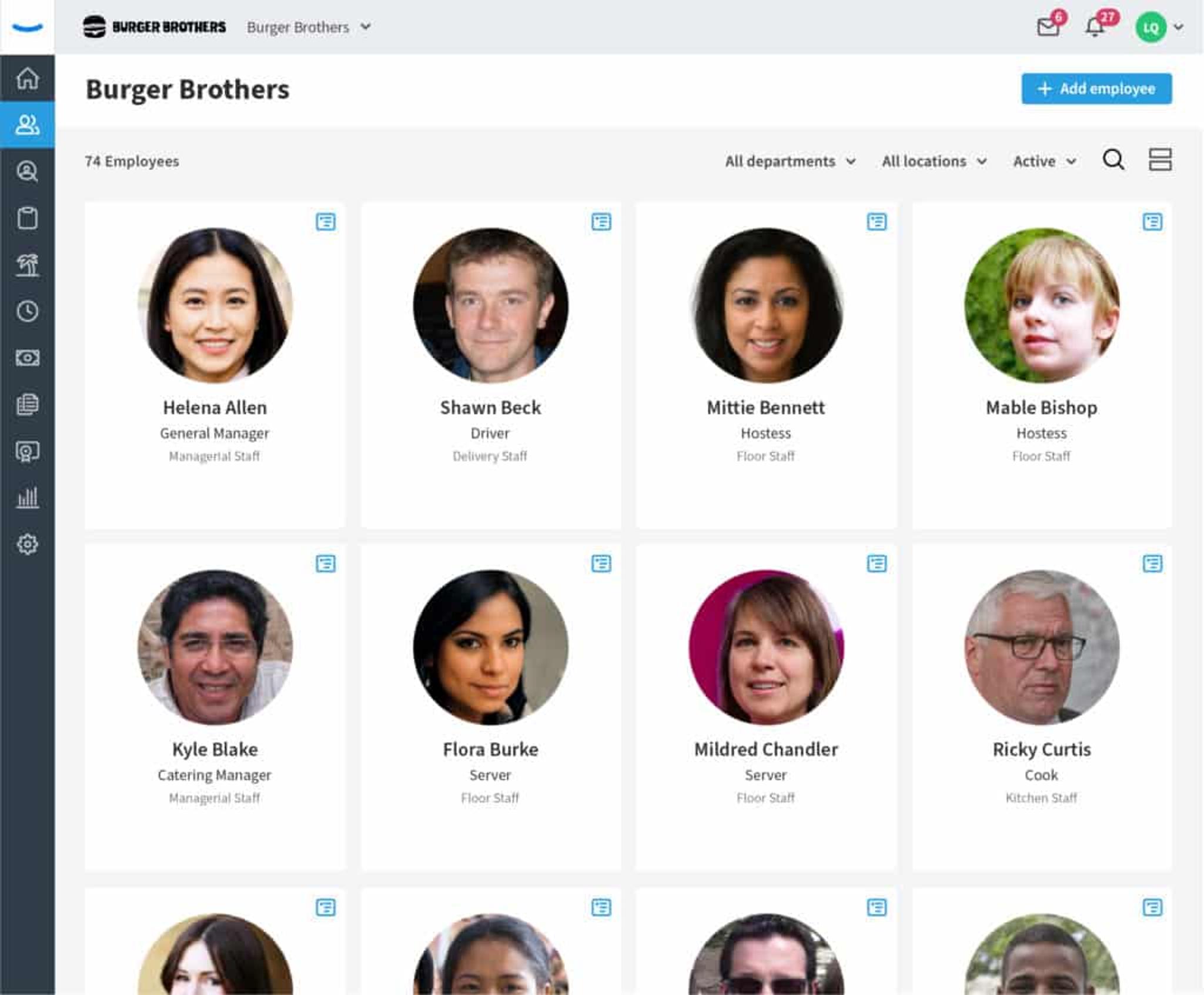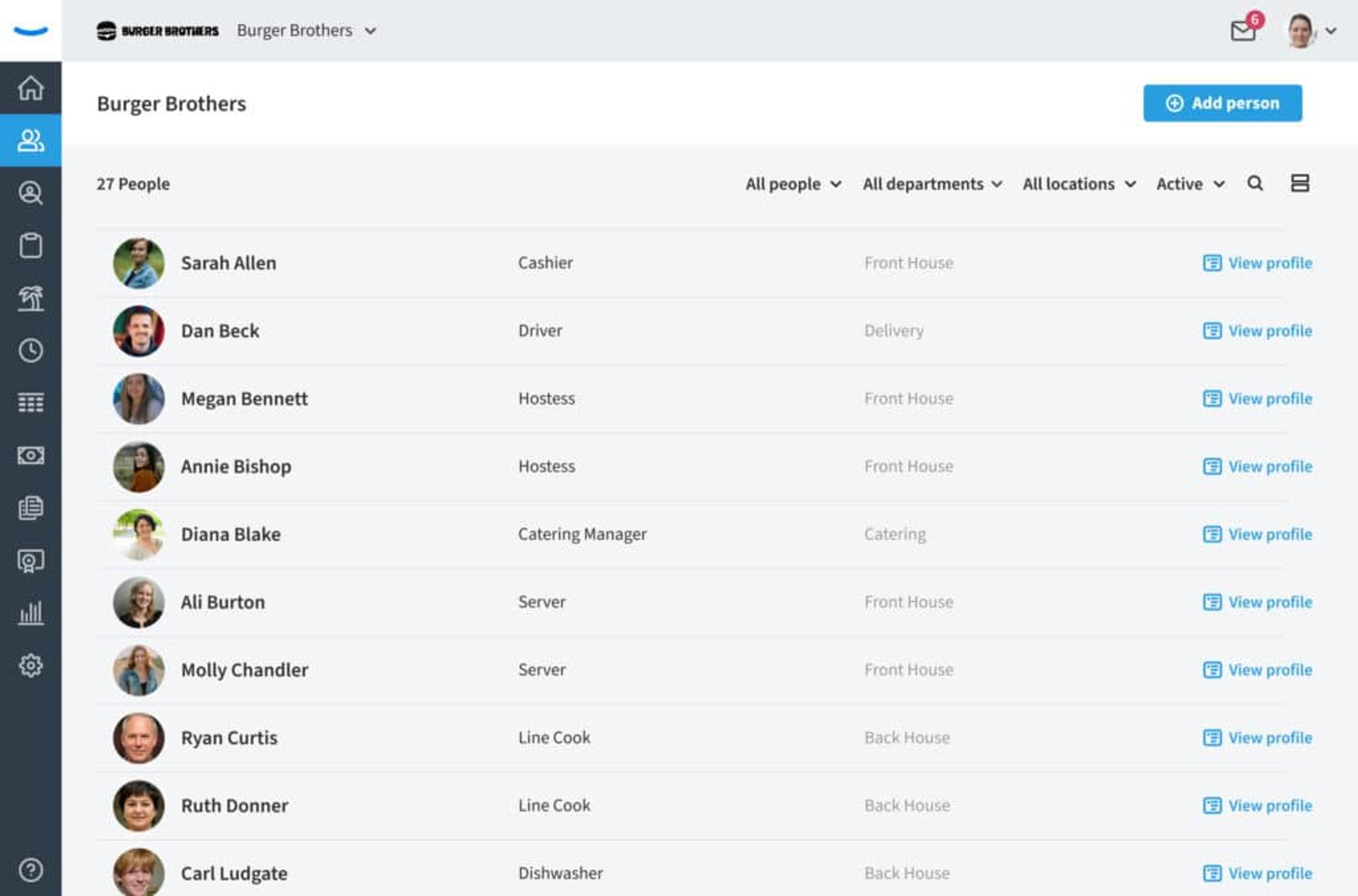
Eddy’s HR Mavericks Encyclopedia
The world's largest free encyclopedia of HR, with 700+ HR articles and podcasts.
Created by Eddy and our HR Mavericks community.
Employee Directory
An employee directory hosts contact, job-related and personal information for all of your company’s employees. Employee directories allow co-workers to collaborate across divisions and help new hires onboard with less stress.
Continue reading to learn what an employee directory is, why having an employee directory is so important, what information to include and other frequently asked questions about employee directories.
Continue reading to learn what an employee directory is, why having an employee directory is so important, what information to include and other frequently asked questions about employee directories.
What Is an Employee Directory?
An employee directory is a source that hosts important information for all members of an organization. Employee directories typically include each employee’s basic identification, contact information, and job title. Some companies include personal information like short biographies and fun facts about their employees. In the past, employee directories were paper-based and required manual organization. As technology evolved, directories moved to virtual spreadsheets, eliminating the need for paper but still requiring manual organization. Today, the best employer directories are created and automated using specialized HR software. Create your very own employee directory with Eddy People! Here's an example of what an employee directory created with HR software might look like:


Why Having an Employee Directory Is So Important
An employee directory allows you to store, manage and update important information about all employees in your organization. Employee directories serve a handful of other important functions, like:
- Contacting and collaborating with other employees. By hosting contact information for all employees in an accessible directory, co-workers can collaborate across divisions and tap into specific skills and abilities.
- Understanding the organizational chart. Employee directories can include job title and classification, creating the ability for employees to identify their position within the organizational hierarchy.
- Scheduling. Location and time zone information can help employees schedule meetings with co-workers in different regions.
- Onboarding new hires. A comprehensive employee directory allows new hires to learn more about their co-workers, creates a level of comfort, and makes the onboarding process more efficient.
What Employee Information To Include in a Directory
The amount of information that you include in your employee directory is completely up to your company. While you can include as much or little information as you want, the following types of information are typically found in an employee directory.
Name
Include the employee’s full name, preferred pronouns, and any nicknames they use.
Department
Adding information about each employee’s department can help people who are looking to get in contact with the right person.
Position
The position, or job title, provides insight into each employee’s role in the organizational hierarchy and within a specific department. Including the job title also makes it easier for your employees to contact specialized co-workers for collaboration.
Email Address
Email is one of the most convenient ways to contact a co-worker for matters that are not time-sensitive. Providing all of your employees’ email addresses allows your staff to communicate without spending time searching for contact information. With the advancement in live chat and instant messaging, you can also include the username or contact information for each relevant channel that your organization uses.
Phone Number
For more important matters, or if some employees prefer verbal communication, phone calls are another form of contact in the workplace. Including employee phone numbers enables your team to communicate while they are working on a job site or located in a different office.
Location
If your company has multiple offices or employs a remote workforce, including information about each employee’s location can help create a sense of community despite the distance. Employees may actively reach out to co-workers in different locations to meet virtually and get to know each other. When employees need to schedule a meeting with a co-worker in a different time zone, an employee directory with location information can help narrow down the options to a time that works for both of them.
Photo
If your employee directory is hosted using specialized HR software, you can let employees upload their headshots to their directory listing. Putting faces to names can help foster a collaborative community in the office and across the company.
Skills and Abilities
Listing specific skills and abilities for each employee makes it easier for your team to get in contact with the best co-worker for any situation. If you need to leverage someone from the marketing team to help promote an internal HR topic, you can use information about skills and abilities to find the right person for the task.
Interests
Including information about each employee’s interests can help connect interested individuals with relevant projects. By including work-related interests that are outside of their role or department, your staff can collaborate across divisions and leverage each unique skill set to complete projects. Letting your employees include interests outside of the office can help create a positive work environment and showcase each employee’s personality within their listing.
Other Personal Information
You can let your employees include additional personal information to create a “profile” and help make your company feel like a community. Additional personal information can include:
- Their birthday
- Short biography/about me section
- Fun facts
- Hire date
Which Employees Should Be Included in a Directory?
You can include as many employees as you want in your directory. To create a welcoming and inclusive environment, include all of the employees that work for your organization — from C-suite level executives to part-time employees. For certain executive-level positions, you may want to consider password protecting their individual contact information or only providing contact information for the individual that handles their scheduling.
Who Should Have Access to Your Employee Directory?
In most cases, only internal employees should have access to your employee directory. This allows your employees to contact each other while ensuring their information remains private. However, there are some public organizations that make their directory public-facing. Some public organizations make their directories public-facing in order to “humanize” their employer brand and company culture. Eddy People helps you to create your very own employee directory. Request a demo today to see how we can simplify your HR processes!
Best Employee Directory Software for 2023
The better your employee directory software is, the more useful the directory will be to employees, management, and HR. Never underestimate the power of an easy-to-use interface and plenty of customization features! Of the many employee directory software options out there, here are some of our favorites.
1. Eddy
Eddy’s employee directory creates a fully customizable employee experience. With a clean and intuitive user interface, Eddy provides comprehensive employee profiles for every member of your organization. You’ll be able to easily access contact information, job details, notes, and PTO requests. The employee directory is just one piece of Eddy’s comprehensive HR software solution.Request a demo of Eddy today
2. Connecteam
Connecteam’s advanced employee directory software helps connect your team and improve communication. Email, text, and live chat capabilities allow employees and managers to communicate and collaborate with ease. Members of the organization can stay engaged with media sharing and social post features.
3. Pingboard
With Pingboard, employees can personalize their profiles with information like their personality type, desk locations, and other fun facts. Pingboard helps facilitate a communal atmosphere by allowing employees to post public recognition when their peers do a job well.
4. Leaveboard
Ditch spreadsheets and create an organization chart through Leaveboard. This platform makes it possible to compile accurate employee records, giving you easy access to important information like work details, time off balance, PTO history and other information. With custom access levels, admins and managers see information that everyday employees can’t.
5. InstaPeople
InstaPeople, an employee directory from InstaCheckin, lets you create interactive organization charts and share them between departments. It syncs with existing directories like Office 365 and Google Suite and has fast search functionality. With Instapeople’s role-based access, you can keep confidential information safe.
Topics

Eddy
Eddy is the all-in-one HR tool built with you in mind. The robust features and ease of use will benefit your company both inside and outside your HR team.
Frequently asked questions
Other Related Terms
Eddy’s HR Mavericks Encyclopedia
Employee Directory
An employee directory hosts contact, job-related and personal information for all of your company’s employees. Employee directories allow co-workers to collaborate across divisions and help new hires onboard with less stress.
Continue reading to learn what an employee directory is, why having an employee directory is so important, what information to include and other frequently asked questions about employee directories.
Continue reading to learn what an employee directory is, why having an employee directory is so important, what information to include and other frequently asked questions about employee directories.
What Is an Employee Directory?
An employee directory is a source that hosts important information for all members of an organization. Employee directories typically include each employee’s basic identification, contact information, and job title. Some companies include personal information like short biographies and fun facts about their employees. In the past, employee directories were paper-based and required manual organization. As technology evolved, directories moved to virtual spreadsheets, eliminating the need for paper but still requiring manual organization. Today, the best employer directories are created and automated using specialized HR software. Create your very own employee directory with Eddy People! Here's an example of what an employee directory created with HR software might look like:


Why Having an Employee Directory Is So Important
An employee directory allows you to store, manage and update important information about all employees in your organization. Employee directories serve a handful of other important functions, like:
- Contacting and collaborating with other employees. By hosting contact information for all employees in an accessible directory, co-workers can collaborate across divisions and tap into specific skills and abilities.
- Understanding the organizational chart. Employee directories can include job title and classification, creating the ability for employees to identify their position within the organizational hierarchy.
- Scheduling. Location and time zone information can help employees schedule meetings with co-workers in different regions.
- Onboarding new hires. A comprehensive employee directory allows new hires to learn more about their co-workers, creates a level of comfort, and makes the onboarding process more efficient.
What Employee Information To Include in a Directory
The amount of information that you include in your employee directory is completely up to your company. While you can include as much or little information as you want, the following types of information are typically found in an employee directory.
Name
Include the employee’s full name, preferred pronouns, and any nicknames they use.
Department
Adding information about each employee’s department can help people who are looking to get in contact with the right person.
Position
The position, or job title, provides insight into each employee’s role in the organizational hierarchy and within a specific department. Including the job title also makes it easier for your employees to contact specialized co-workers for collaboration.
Email Address
Email is one of the most convenient ways to contact a co-worker for matters that are not time-sensitive. Providing all of your employees’ email addresses allows your staff to communicate without spending time searching for contact information. With the advancement in live chat and instant messaging, you can also include the username or contact information for each relevant channel that your organization uses.
Phone Number
For more important matters, or if some employees prefer verbal communication, phone calls are another form of contact in the workplace. Including employee phone numbers enables your team to communicate while they are working on a job site or located in a different office.
Location
If your company has multiple offices or employs a remote workforce, including information about each employee’s location can help create a sense of community despite the distance. Employees may actively reach out to co-workers in different locations to meet virtually and get to know each other. When employees need to schedule a meeting with a co-worker in a different time zone, an employee directory with location information can help narrow down the options to a time that works for both of them.
Photo
If your employee directory is hosted using specialized HR software, you can let employees upload their headshots to their directory listing. Putting faces to names can help foster a collaborative community in the office and across the company.
Skills and Abilities
Listing specific skills and abilities for each employee makes it easier for your team to get in contact with the best co-worker for any situation. If you need to leverage someone from the marketing team to help promote an internal HR topic, you can use information about skills and abilities to find the right person for the task.
Interests
Including information about each employee’s interests can help connect interested individuals with relevant projects. By including work-related interests that are outside of their role or department, your staff can collaborate across divisions and leverage each unique skill set to complete projects. Letting your employees include interests outside of the office can help create a positive work environment and showcase each employee’s personality within their listing.
Other Personal Information
You can let your employees include additional personal information to create a “profile” and help make your company feel like a community. Additional personal information can include:
- Their birthday
- Short biography/about me section
- Fun facts
- Hire date
Which Employees Should Be Included in a Directory?
You can include as many employees as you want in your directory. To create a welcoming and inclusive environment, include all of the employees that work for your organization — from C-suite level executives to part-time employees. For certain executive-level positions, you may want to consider password protecting their individual contact information or only providing contact information for the individual that handles their scheduling.
Who Should Have Access to Your Employee Directory?
In most cases, only internal employees should have access to your employee directory. This allows your employees to contact each other while ensuring their information remains private. However, there are some public organizations that make their directory public-facing. Some public organizations make their directories public-facing in order to “humanize” their employer brand and company culture. Eddy People helps you to create your very own employee directory. Request a demo today to see how we can simplify your HR processes!
Best Employee Directory Software for 2023
The better your employee directory software is, the more useful the directory will be to employees, management, and HR. Never underestimate the power of an easy-to-use interface and plenty of customization features! Of the many employee directory software options out there, here are some of our favorites.
1. Eddy
Eddy’s employee directory creates a fully customizable employee experience. With a clean and intuitive user interface, Eddy provides comprehensive employee profiles for every member of your organization. You’ll be able to easily access contact information, job details, notes, and PTO requests. The employee directory is just one piece of Eddy’s comprehensive HR software solution.Request a demo of Eddy today
2. Connecteam
Connecteam’s advanced employee directory software helps connect your team and improve communication. Email, text, and live chat capabilities allow employees and managers to communicate and collaborate with ease. Members of the organization can stay engaged with media sharing and social post features.
3. Pingboard
With Pingboard, employees can personalize their profiles with information like their personality type, desk locations, and other fun facts. Pingboard helps facilitate a communal atmosphere by allowing employees to post public recognition when their peers do a job well.
4. Leaveboard
Ditch spreadsheets and create an organization chart through Leaveboard. This platform makes it possible to compile accurate employee records, giving you easy access to important information like work details, time off balance, PTO history and other information. With custom access levels, admins and managers see information that everyday employees can’t.
5. InstaPeople
InstaPeople, an employee directory from InstaCheckin, lets you create interactive organization charts and share them between departments. It syncs with existing directories like Office 365 and Google Suite and has fast search functionality. With Instapeople’s role-based access, you can keep confidential information safe.
Topics

Eddy
Eddy is the all-in-one HR tool built with you in mind. The robust features and ease of use will benefit your company both inside and outside your HR team.
Frequently asked questions
Other Related Terms
Eddy's HR Newsletter
Sign up for our email newsletter for helpful HR advice and ideas.


